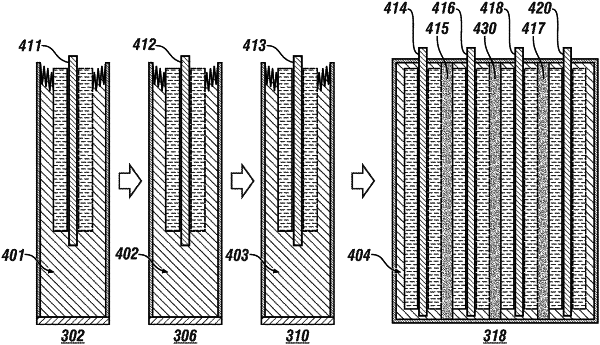| CPC H01M 4/0416 (2013.01) [H01M 10/0565 (2013.01); H01M 10/0568 (2013.01); H01M 10/0569 (2013.01)] | 20 Claims |

|
1. A method for fabricating a cell anode for a lithium ion battery cell, the method comprising:
forming a solid electrolyte interface (SEI) layer on a raw anode, including:
applying a first SEI-generating electrolyte to the raw anode to form a first intermediate anode;
applying a second SEI-generating electrolyte to the first intermediate anode to form a second intermediate anode;
post-processing the first intermediate anode to avoid a side reaction between the first SEI-generating electrolyte and the second SEI-generating electrolyte, cross-contamination of the second SEI-generating electrolyte, and dilution of the second SEI-generating electrolyte;
applying a third SEI-generating electrolyte to the second intermediate anode to form the cell anode;
post-processing the second intermediate anode to avoid a side reaction between the second SEI-generating electrolyte and the third SEI-generating electrolyte, cross-contamination of the third SEI-generating electrolyte, and dilution of the third SEI-generating electrolyte;
wherein applying the respective first, second, and third SEI-generating electrolyte occurs in an inert environment at atmospheric pressure at a temperature of from 0° C. to 200° C. for a time period of from 30 seconds to 72 hours with an applied potential of from 0V to 10V, an applied current having an areal current density of from 0 mA/cm2 to 100 mA/cm2, and an applied surface pressure on the respective raw anode, first intermediate anode, and second intermediate anode of from 0.05 MPa to 30 MPa;
concurrent to applying the third SEI-generating electrolyte, monitoring the cell anode with non-destructive testing in real-time to identify either: a) an acceptable quality of the third SEI-generating electrolyte to thereby form the SEI layer on the raw anode or b) a defect in at least one of structural integrity, consistency, thickness, and morphology of the third SEI-generating electrolyte; and
after identifying the defect, i) reapplying the third SEI-generating electrolyte to thereby form the SEI layer on the raw anode or ii) recycling the cell anode;
wherein the cell anode includes the raw anode having the SEI layer; and
wherein the raw anode includes a metallic strip having an electroactive material deposited on at least one side.
|